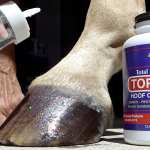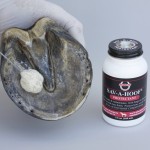Are Hoof Dressings Natural or Synthetic Products?
Organic compounds are used in 99% of hoof dressings and conditioners. Most of these organic compounds are really fats with fancy names. The fats come from many different sources. Animal fats are classified as lanolin, emu oil, fish oil, neat foot oil, beeswax; and fats from plants are really vegetable oil. These include tea tree oil, aloe vera, pine tar, caster oil, linseed oil, cottonseed oil, wheat germ oil, peppermint oil, and jojoba oil.
Advantages of hoof dressings made from these animal or vegetable organic compounds –
The function of the fat is to provide a cosmetic shine and to keep the hoof supple or flexible. The fat’s function is to temporarily seal-in the internal moisture in the hoof. They keep the internal moisture from evaporating from inside the hooves. This is how keratin is moisturized. The hoof, hair, and skin are all made of keratin. The good news is that organic compounds are plentiful and cheap. This is why fats have been used for centuries as a moisturizer.
Disadvantages of hoof dressings made from animal or vegetable organic compounds –
Most hoof oils are vegetable oil with a fancy name. Animals fats are also used. Lanolin comes from sheep and is a popular moisturizer for skin and hooves. However, like your next shower, these organic compounds wash off or wear out quickly. Hair conditioners, shampoos, and hand soap are also made from animal and vegetable fats.
Organic dressings do not last long and must be reapplied to the hoof frequently to be affective. Some fats remain tacky and can attract contaminates. Fats offer little protection from abrasion and do not seal cracks and nail holes very well.
Is there a 21st century option to these organic compounds?
The Horse-Journal said that organic hoof dressings are not very effective. They suggested consumers save their money. They liked the  synthetic compounds for durability and long life. Unfortunately, these compounds cannot be applied to the bottom of the feet, sole and frog. This is where hoof transpiration takes place. Synthetic sealants prevent the hoof from breathing so they should not be used on the bottom of the hooves.
synthetic compounds for durability and long life. Unfortunately, these compounds cannot be applied to the bottom of the feet, sole and frog. This is where hoof transpiration takes place. Synthetic sealants prevent the hoof from breathing so they should not be used on the bottom of the hooves.

Improves frog function
SBS EQUINE hoof researchers have been developing a class of hoof conditioners made from natural protein compounds. They dry hard and fast like synthetic products do. The result is a longer lasting product that seals in internal moisture from the blood supply as well as repel external moisture from the environment. The best feature of these natural compounds are that they allow the hoof to breathe, so they can be applied to the entire hoof capsule, including the hoof wall, sole, and frog. Total protection in both dry or wet conditions!
For more information on 21st Century Hoof Conditioners visit www.sbsequine.com.
For extremely wet feet, SBS recommends Sav-A-Hoof Protectant, which utilizes carnauba emulsions that dry hard to seal out external moisture and contaminates. For more information: www.sbsequine.com




